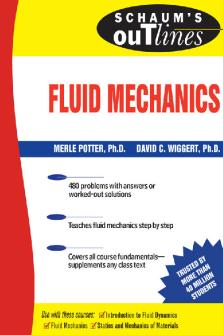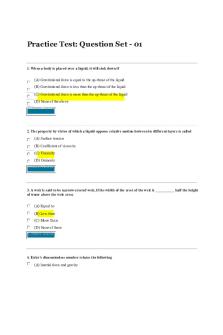FLUID MECHANICS ( 2019-2020) DOCX

| Title | FLUID MECHANICS ( 2019-2020) |
|---|---|
| Author | Yuri G Melliza |
| Pages | 67 |
| File Size | 3.3 MB |
| File Type | DOCX |
| Total Downloads | 38 |
| Total Views | 133 |
Summary
ME 27 EF - FLUID MECHANICS/HYDRAULICS By: Yuri G. Melliza COURSE DESCRIPTION This class provides students with an introduction to principal concepts and methods of fluid mechanics. Topics covered in the course include pressure, hydrostatics, and buoyancy; open systems and control volume analysis; ma...
Description
ME 27 EF - FLUID MECHANICS/HYDRAULICS By: Yuri G. Melliza COURSE DESCRIPTION This class provides students with an introduction to principal concepts and methods of fluid mechanics. Topics covered in the course include pressure, hydrostatics, and buoyancy; open systems and control volume analysis; mass conservation and momentum conservation for moving the models necessary to study, analyze, and design fluid systems through the application of these concepts, and to develop the problem-solving skills essential to good engineering practice of fluid mechanics in practical applications. Students will have the opportunity to demonstrate a familiarity and ability to work on fluid mechanics. These outcomes will be demonstrated through an assessment of quizzes, assignments and major examinations. GENERAL OBJECTIVES By the end of this course, you should expect to be able to calculate: fundamental fluid properties for different fluids and flows forces on objects submerged in both static and flowing fluids pressures in both static and flowing fluids, and the velocities associated with different flows forces in complicated momentum balance problems energy loss and the flow rates associated with different flow networks in channels and pipes dimensionless numbers important for design of experiments and practical engineering work numerical solutions for simple fluid flow problems properties of a boundary layer, both turbulent and laminar problems with the application of Bernoulli's Principle Fluid Mechanics - it is a science that deals with the mechanics of fluids (liquid or gas) and is based on the same fundamental principles employed in the mechanics of solids. STUDENT COURSE OUTCOMES This is an introductory course on fluid motion, the forces that fluids exert, and the forces that are exerted on them. The study of fluid mechanics has numerous engineering applications. Fluids interact with structures such as high-rise buildings, dams, and bridges and the static and dynamic loads imposed by the fluids must be considered in the design and construction of these structures. Cars, aircraft, and ships all move through fluids, and frictional (fluid drag) forces represent a major energy sink. Water is an important resource to California and fluid mechanical problems abound in the complex system of dams, aqueducts, treatment plants, pipes, and valves used to deliver water to urban and agricultural consumers. Finally, the motions of contaminants in water and air are governed by the mechanics of fluid flow. After this course, the students are expected to: Branches of Fluid Mechanics 1. Fluid Static - deals with the forces exerted by or upon the fluid at rest. 2. Kinematics - deals with velocities and accelerations without considering forces and energy. 3. Hydrodynamics - deals with the relation of velocities and accelerations and the forces exerted by or upon the fluid in motion. Fluid - is a substance capable of flowing and having particles which easily moved and changed their relative position without the separation of mass. Distinction between Liquid and Gas Liquid 1. It has a free surface 2. A given quantity of liquid occupies a given volume of a container 3. It is incompressible Gas 1. It has no free surface 2. A given quantity of gas occupies all portions of the container regardless of its shape and size. 3. It is compressible Free Surface - a surface in which all pressures can be removed except its own vapor pressure. Vapor - is a gas in which its pressure and temperature are such that very near to its liquid state. PROPERTIES OF FLUIDS 1. Density ( ): It is the mass on a unit volume. ρ= m V kg m3 2. Specific Volume ( ): It is the volume per unit mass, or the reciprocal of its density. υ= V m m 3 kg 3. Specific Weight or Weight Density ( ): It is the weight on a unit volume. γ= W V KN m3 γ= mg 1000V = ρg 1000 KN m3 4. Specific Gravity or Relative Density (S):...
Similar Free PDFs

Fluid Mechanics
- 260 Pages

Fluid Mechanics
- 796 Pages

Fluid Mechanics
- 8 Pages

fluid mechanics
- 8 Pages

Fluid mechanics history essay
- 16 Pages

Nestle - Summary Fluid Mechanics
- 3 Pages

Fluid Mechanics 2 MCQ
- 109 Pages

Fluid Mechanics Lab Report
- 35 Pages

Fluid Mechanics lecture notes
- 133 Pages

Introduction to Fluid Mechanics
- 321 Pages

Fluid Mechanics, Lecture 4
- 27 Pages

Fluid Mechanics - External Flow
- 7 Pages

Fluid Mechanics Cheat Sheet
- 3 Pages

Fluid Mechanics - MCQ
- 127 Pages

FLUID MECHANICS ( 2019-2020)
- 67 Pages
Popular Institutions
- Tinajero National High School - Annex
- Politeknik Caltex Riau
- Yokohama City University
- SGT University
- University of Al-Qadisiyah
- Divine Word College of Vigan
- Techniek College Rotterdam
- Universidade de Santiago
- Universiti Teknologi MARA Cawangan Johor Kampus Pasir Gudang
- Poltekkes Kemenkes Yogyakarta
- Baguio City National High School
- Colegio san marcos
- preparatoria uno
- Centro de Bachillerato Tecnológico Industrial y de Servicios No. 107
- Dalian Maritime University
- Quang Trung Secondary School
- Colegio Tecnológico en Informática
- Corporación Regional de Educación Superior
- Grupo CEDVA
- Dar Al Uloom University
- Centro de Estudios Preuniversitarios de la Universidad Nacional de Ingeniería
- 上智大学
- Aakash International School, Nuna Majara
- San Felipe Neri Catholic School
- Kang Chiao International School - New Taipei City
- Misamis Occidental National High School
- Institución Educativa Escuela Normal Juan Ladrilleros
- Kolehiyo ng Pantukan
- Batanes State College
- Instituto Continental
- Sekolah Menengah Kejuruan Kesehatan Kaltara (Tarakan)
- Colegio de La Inmaculada Concepcion - Cebu
